
October is the release date for a Martin Scorsese movie, Killers of the Flower Moon, based on a David Grann book of the same name, on the string of murders in Oklahoma a century ago, which left untold numbers of Osage Indians dead.
As is so often the case, the murders were a violation of the Sixth Commandment (Thou shall not commit murder), motivated by violations of the Eighth Commandment (Thou shall not steal) and the Tenth Commandment (Thou shall not covet anything that is your neighbor’s). The murders were motivated by a desire to obtain the oil wealth belonging to members of the Osage tribe in Oklahoma.
Like many other tribes, the Osage were among those moved to “Indian Territory” (now Oklahoma) in the 19th century. In the early years of the 20th century, with the increasingly wider use of automobiles, which burned gasoline — a refined product of the large amounts of oil found in the Osage Nation Reservation — members of the tribe became fabulously wealthy. At its peak, the tribe earned more than $30 million in annual revenue — during a time, of course, before the Federal Reserve began its inflationary policies greatly devaluing the money supply.
Since the royalties were paid to the tribe as a whole, with each tribal member receiving a “headright” — or equal share — those millions of dollars allowed individuals to purchase mansions, automobiles, and just about anything else money could buy a hundred years ago. With fewer than 2,500 enrolled tribal members, this made multimillionaires out of Osages. An Osage family of five took in more than $65,000 a year in the decade of the 1920s, an amount worth about $1 million annually in present-day dollars. Some tribal members were known to even buy another car after the first one ran out of gasoline.
After large quantities of oil were found on Osage land in 1894 (about the time the internal-combustion engine began powering cars), Henry Foster convinced the Bureau of Indian Affairs (BIA) to give him exclusive privileges to drill for that oil, with the requirement that he pay the tribe 10 percent royalty on all petroleum sales from that oil. As has always been the case, the only way to make money in an honest fashion is to serve others — give them something they need. Of course, some have been the beneficiaries of gifts through inheritance and the like, but others do not want to obtain wealth in honest and moral ways, and instead begin to covet the wealth of others. For some, either because of fear of running afoul of the law or a similar social control, this remains just a sin of the human heart, and no overt act is the result.
But some are willing to take wealth from others by force or fraud — and some even go to the extreme of committing murder.
That was the case with the murders of Osage tribal members, murders committed to get their wealth. Perhaps the most prolific of these mastermind killers (but not the only one) was Oklahoma rancher William King Hale — who called himself the “King of the Osage Hills.” Some of the details of this conspiracy are still murky even to this day, but it evidently began even before 1920. Hale’s plot was instigated in 1917, when he pushed his nephew, Ernest Burkhart, to marry Mollie Kyle, an Osage headright owner. Over time, every close relative of Mollie’s died under mysterious circumstances, including “illnesses,” a gun shot to the head (her sister Anna), and an explosion that killed her sister Ruth, along with her husband and a white maid.
Questionable autopsies were performed on some victims, and some morticians put bodies in the ground before an autopsy could be performed. As the death toll mounted (officially 24 total, but there are indications it was most likely many more than that, perhaps hundreds), two white men were themselves murdered when they tried to intervene. As John Dwyer writes in his award-winning The Oklahomans, Volume Two, one man was on his way to alert state officials in Oklahoma City, while the other was traveling to Washington, D.C., to speak with federal officials.
In Killers of the Flower Moon, Grann explained how some of the more subtle murders were perpetrated. “The perpetrators of the crime would get an Indian intoxicated … the (killers) would inject an enormous amount of morphine under the armpit of the drunken Indian, which resulted in his death.”
The death certificate would then read “death from alcoholic poisoning.”
The new Federal Bureau of Investigation, under its young director, J. Edgar Hoover, was instrumental in getting Tom White of Pawhuska, a former Texas Ranger, to work the case. White persuaded the governor of Oklahoma, Martin Trapp, to give him permission to assemble a crack team of investigators, include State Crime Bureau agent Luther Bishop of Oklahoma City. His investigations led him to Hale and eventually enough evidence to get Hale arrested, indicted, and tried.
Although getting a conviction proved more difficult, Hale was finally convicted and sent to Leavenworth Prison in Kansas for 20 years. His nephew Burkhart had himself been convicted in 1926.
Grann names additional suspects that have emerged over the past several decades, as more evidence has been uncovered. One murder was of investigator Luther Bishop himself.
Many of those involved in these murders died without justice ever being meted out — at least not in this life.
The movie, with Leonardo de Caprio, Lillie Gladstone, and Robert de Niro, is based on this tragic story, and has been well-received by those fortunate enough to have seen previews, including the former chief of the tribe, Jim Gray, who greatly praised the film.
Steve Byas was the editor of John Dwyer’s award-winning history of Oklahoma, The Oklahomans: The Story of Oklahoma and Its People, published in two volumes.
Shop For Night Vision | See more…
Shop For Survival Gear | See more…
-
Sale!

Portable Mini Water Filter Straw Survival Water Purifier
Original price was: $29.99.$14.99Current price is: $14.99. Add to cart -
Sale!

Tactical Camo Nylon Body Armor Hunting Vest With Pouch
Original price was: $49.99.$39.99Current price is: $39.99. Select options This product has multiple variants. The options may be chosen on the product page -
Sale!

Stainless Steel Survival Climbing Claw Carabiner Multitool Folding Grappling Hook
Original price was: $19.99.$9.99Current price is: $9.99. Add to cart

















































